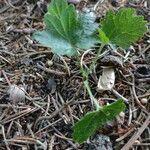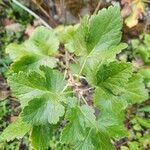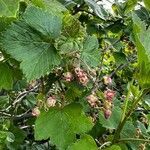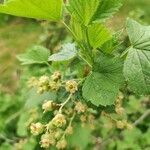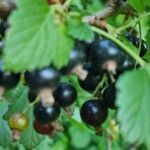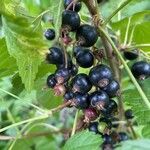Unarmed, deciduous shrub to 1.5-(2.5) m high, with a characteristic strong odour when bruised; branches and shoots ± erect, glabrous except when young. Lvs plicately folded in bud with petioles to c. 8 cm long, slightly clasping at base; lamina broadly deltoid, 6-11 × 8-13 cm, often smaller on upper part of flowering stems, palmately lobed, with 3, ± triangular lobes; lower surface glabrate with fairly numerous prominent yellow glandular scales; upper surface slightly shining, somewhat rugose; margins crenate to coarsely serrate; base cordate. Racemes pendent, 5-15-flowered; fls ± fragrant. Hypanthium 2-4 mm diam., broadly campanulate to orbicular, green or reddish green, glabrous or hairy, with sessile, yellow, glandular scales. Sepals 3-5 mm long, triangular to oblong-elliptic, green or reddish green, ± villous inside, reflexed at anthesis. Petals 2.5-4 mm long, oblong to broadly ovate or broadly elliptic, white or greenish white. Filaments 2-4 mm long. Fr. 7-10 mm diam. (to 15 mm in cultivation), globose, black, opaque, lacking bloom, glabrous; flesh very aromatic and moderately sweet.
Erect, unarmed shrub; lvs 3–5-lobed to about the middle, dotted with resinous glands beneath; racemes drooping; pedicels 2–8 mm, much exceeding the minute, ovate bracts; hypanthium above the ovary short-campanulate; sep greenish-purple within; ovary commonly with sessile resinous glands; fr black; 2n=16. Native of Eurasia, occasionally escaped from cult.
A small shrub. It grows 2 m high and spreads 1.8 m wide. It loses its leaves during the year. It grows as a group of canes. The young stems are downy. The leaves have 3-5 lobes. These are downy underneath. The flowers are yellow-green with red centres. They hang down and are downy. The fruit hang in loose bunches.
